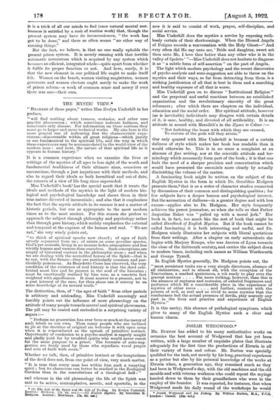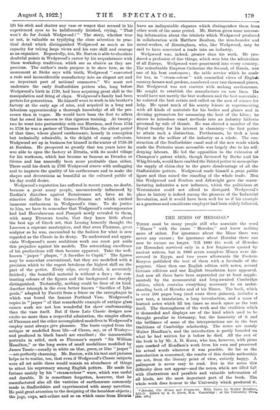JOSIAH 'WEDGWOOD.*
Mn. BURTON has added to his many authoritative works on ceramics the best account of Wedgwood that has yet been written, with a large number of exquisite plates that illustrate adequately for the first time the productions of Etruria in all their variety of form and colour. Mr. Burton was specially qualified for the task, not merely by his long, practical experience as a potter but also by his personal knowledge of the works at Etruria when, a generation ago, they remained much as they had been in Wedgwood's day, with the old machines and the old moulds and with veteran workmen who could repeat the sayings handed down to them by their grandfathers who were in tb,s employ of the founder. It was reported, for instance, that when Wedgwood made his daily round of the workshops he would • Josiah Wedgwood and his Pottery. By WW1= Barton, MA., Lamest : Came& MIL mei
Jilt his stick and shatter any vase or teapot that seemed in his experienced eyes to be indifferently finished, crying, "That won't do for Josiah Wedgwood 1" The story, whether true or not, is valuable as typifying the close attention to prac- tical detail which distinguished Wedgwood as much as his capacity for taking large views and his rare skill and courage as an organizer. Repeatedly, too, Mr. Burton is able to elucidate doubtful points in Wedgwood's career by his acquaintance with these workshop traditions, which are as elusive as they are precious. The author's main purpose is to show how, as the monument at Stoke says with truth, Wedgwood "converted a rude and inconsiderable manufactory into an elegant art and an important part of national commerce." We must not underrate the early Staffordshire potters who, long before Wedgwood's birth in 1730, had been acquiring great skill in the manipulation and firing of clays. Wedgwood's family had been potters for generations. He himself went to work in his brother's factory at the early age of nine, and acquired in a long and laborious apprenticeship a thorough knowledge of all the pro- cesses then in vogue. He would have been the first to affirm that he owed his success to this rigorous training. At twenty- two he went into partnership with one Harrison, and from 1754 to 1758 he was a partner of Thomas Whieldon, the ablest potter of that time, whose glazed earthenware, homely in conception but technically admirable, is the delight of many collectors. Wedgwood set up in business for himself in the winter of 1758-59 at Burslem. He prospered so greatly that ten years later he was able to open the factory at Etruria, with its model village for his workmen, which has become as famous as Dresden or Sevres and has assuredly been more profitable than either. There until his death in 1795 Wedgwood strove with unflagging zeal to improve the quality of his earthenware and to make the shapes and decorations as beautiful as the cultured public of his day could desire.
Wedgwood's reputation has suffered in recent years, no doubt, because a great many people, unconsciously influenced by Ruskin's diatribes against Renaissance art, have an in- stinctive dislike for the Graeco-Roman art which excited immense enthusiasm in Wedgwood's time. To do justice to him, we have to remember that Wedgwood's contemporaries had had Herculaneum and Pompeii newly revealed to them, with many Etruscan tombs, that they knew little about the best age of Greek art, that Leasing honestly thought the Laocoon a supreme masterpiece, and that even Flaxman, great sculptor as he was, succumbed to the fashion for what is now regarded as the Classic in its decay. To understand and appre- ciate Wedgwood's more ambitious work one must put aside this prejudice against his models. The astonishing excellence of his productions will then become apparent. Take the well- known " jasper " plaque, "A Sacrifice to Cupid." The figures may be somewhat conventional, but they are modelled with a precision which to the expert betokens the highest skill on the part of the potter. Every edge, every detail, is accurately finished ; the beautiful material is without a flaw ; the con- trasting colours of the figures and the background are sharply distinguished. Technically, nothing could be finer of its kind. Another triumph is the even better known "Sacrifice of Iphi- gents," adapted by Pacetti from a frieze on the sarcophagus in which was found the famous Portland Vase. Wedgwood's copies in " jasper " of that remarkable example of antique glass cameo work are not less wonderful for sheer craftsmanship than the vase itself. But if these Late Classic designs now excite no more than a respectful admiration, the simpler efforts of Flaxman and the other accomplished modellers in Wedgwood's employ must always give pleasure. The busts copied from the antique or modelled from life—of Cicero, say, or of Wesley— and produced in black basalt are excellent ; the innumerable portraits in relief, such as Flaxman's superb "Sir William Hamilton," or the long series of small medallions modelled by James Tassie—usually in white on blue, green, or lilac " jasper " —are perfectly charming. Mr. Burton, with his text and pictures helps us to realize, too, that even if Wedgwood's Classic subjects were all set aside there would remain an abundance of things to attest his supremacy among English potters. He made his fortune mainly by his " cream-colour " ware, which was useful and durable. It is sometimes forgotten, however, that he manufactured also all the varieties of earthenware commonly made in Staffordshire and experimented with many novelties. He paid great attention to the designing of the humblest objects ; the jugs, cups, salt-cellars and so on which came from Etruria have an indisputable elegance which distinguishes them from other work of the same period. Mr. Burton gives some interest- ing information about the trinkets which Wedgwood produced in collaboration with Matthew Boulton, the iron-founder and metal-worker, of Birmingham, who like Wedgwood, may be said to have converted a trade into an industry.
Wedgwood was, indeed, greater than his work. He pro- duced a profusion of fine things, which won him the admiration of all Europe. Wedgwood ware penetrated into every country. The redoubtable Empress Catherine the Second, of Russia, was one of his best customers ; the table service which he made for her, in " cream-colour " with enamelled views of English country-houses and gardens, numbered over two thousand pieces. But Wedgwood was not content with making earthenware. He sought to establish the manufacture on new lines. He would have not merely the beat workmen and the best materials ; he enlisted the best artists and called on the men of science for help. He spent much of his scanty leisure in experimenting with all kinds of materials for his bodies and glazes and in devising pyrometers for measuring the heat of the kilns ; he strove to introduce exact methods into an industry hitherto governed by rule of thumb. He was elected a member of the Royal Society for his interest in chemistry—the first potter to attain such a distinction. Furthermore, he took a keen interest in the welfare of the industry as a whole. The con- struction of the Staffordshire canal and of the new roads which made the Potteries more accessible was largely due to his self- denying labours. He led the opposition to the extension of Champion's patent whioh, though favoured by Burke and his Whig friends, would have enabled the Bristol potter to monopolize the supply of china-clay to the grave disadvantage of all the Staffordshire potters. Wedgwood made himself a great public figure and thus raised the standing of the whole trade. Men like Wedgwood and Boulton and Arkwright gave the manu- facturing industries a new influence, which the politicians at Westminster could not afford to disregard. Wedgwood's place in history is indeed among the pioneers of the Industrial Revolution, and it would have been well for us if his example as a generous and considerate employer had been widely followed.



































 Previous page
Previous page